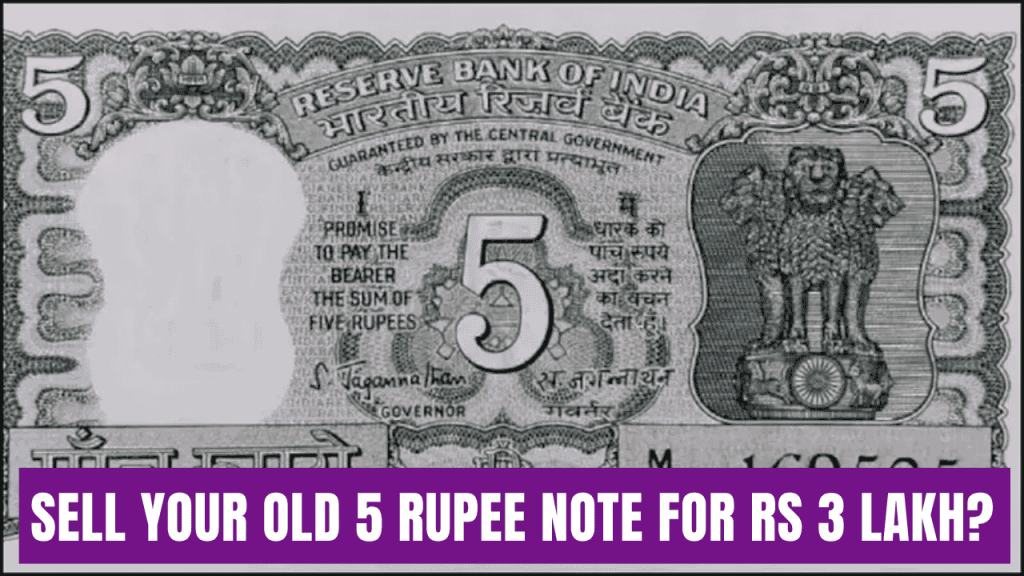
In today’s challenging economic climate, discovering alternative income sources has become essential, particularly for younger generations facing employment hurdles. Surprisingly, a seemingly insignificant item like an old ₹5 note could potentially transform into a substantial windfall of up to ₹3 lakh. This opportunity exists because certain rare currency notes have become highly sought-after collectibles, commanding impressive prices in specialized markets.
What Makes a ₹5 Note Valuable?
Not every ₹5 note will fetch a premium price. Only specific variants with particular characteristics are considered valuable to collectors. Before searching through your belongings, familiarize yourself with these critical identifying features:
Essential Characteristics of Valuable ₹5 Notes
The truly valuable notes must possess all of the following attributes:
- Serial Number 786: This specific numerical sequence is the most crucial element. The number 786 holds special significance in Islamic numerology, representing the Bismillah phrase, making notes with this number highly desirable.
- Mahatma Gandhi Portrait: The note should feature the standard portrait of Mahatma Gandhi that appears on modern Indian currency.
- Tractor with Farmer Illustration: The reverse side must display a specific agricultural scene showing a tractor with a farmer operating it.
- Tiller Detail: A distinguishing feature is the presence of a tiller implement visible behind the tractor. This small detail significantly increases the note’s rarity and value.
When all these elements combine in a single note, particularly in well-preserved condition, the result is a highly collectible item that can command extraordinary prices from the right buyers.
Potential Value Assessment
The market value for these rare notes varies based on condition, specific serial number arrangement, and current collector demand. Here’s what you might expect:
| Condition | Estimated Value | Notes |
|---|---|---|
| Mint (Uncirculated) | ₹2.5 – 3 lakh | Perfect condition with no signs of handling or circulation |
| Excellent | ₹1.5 – 2.5 lakh | Very minor handling with original crispness intact |
| Good | ₹75,000 – 1.5 lakh | Shows signs of circulation but no damage |
| Fair | ₹20,000 – 75,000 | Visible wear, minor stains, or fold marks |
| Poor | ₹5,000 – 20,000 | Significant wear, tears, or stains |
Multiple notes with these characteristics can multiply your potential earnings. For instance, possessing four mint-condition notes with the desired features could theoretically yield up to ₹12 lakh if sold to enthusiastic collectors.
How to Sell Your Valuable Note
Once you’ve identified a potentially valuable note, the next step is connecting with interested buyers. Online platforms offer the most convenient avenue for these transactions:
Step-by-Step Selling Process
- Select a Suitable Platform
- Quikr (www.quikr.com)
- OLX
- eBay (for international collectors)
- Specialized numismatic forums and websites
- Create a Seller Account
- Register with your basic details
- Verify your account (usually through email or phone)
- Complete your profile with contact information
- Prepare Your Listing
- Take high-resolution photographs showing both sides of the note
- Ensure the serial number is clearly visible
- Capture any distinctive features or special markings
- Include images showing the note’s condition (corners, edges, etc.)
- Craft a Detailed Description
- Specify the serial number with emphasis on the 786 sequence
- Describe all required features (Gandhi portrait, tractor scene, tiller)
- Honestly assess and describe the note’s condition
- Mention any unique aspects that might increase value
- Set Your Asking Price
- Research current market rates for similar notes
- Consider starting slightly higher to allow negotiation room
- Be prepared to provide justification for your pricing
- Communicate with Potential Buyers
- Respond promptly to inquiries
- Be transparent about the note’s condition and authenticity
- Consider secure payment methods (escrow services for high-value transactions)
- Arrange Secure Transaction
- For local buyers, consider meeting in public places (bank branches are ideal)
- For distant buyers, use registered/insured shipping methods
- Document the transaction with receipts and confirmation messages
Important Precautions and Considerations
Before engaging in currency note sales, be aware of these important factors:
Legal and Safety Considerations
- Regulatory Status: The Reserve Bank of India does not officially recognize or regulate the collecting and trading of currency notes as collectibles. This activity exists in a somewhat gray market.
- Authentication Challenges: Unlike coins, notes lack standardized grading systems in India, making authentication more subjective.
- Scam Awareness: The high values involved make this market attractive to scammers. Never share banking details or make advance payments without securing the item.
- Personal Safety: When meeting potential buyers, choose public locations, preferably during daylight hours. Bank premises offer both security and immediate verification options.
- Documentation: Maintain records of all communications and transactions, including photographs of the note before shipping or handover.
Understanding the Collector’s Perspective
To maximize your selling potential, it helps to understand why collectors value these specific notes:
Motivations Behind High Valuations
- Numerical Significance: The number 786 carries deep spiritual meaning in Islamic tradition, making notes with this serial number particularly desirable among certain communities.
- Historical Association: The tractor design represents a specific era in Indian currency history, documenting the nation’s agricultural focus and development.
- Rarity Factor: The combination of all required elements occurs in a limited number of notes, many of which have been lost or damaged over time.
- Investment Potential: Like art or antiques, rare currency items often appreciate in value over time, making them attractive for collectors seeking both passion and profit.
- Cultural Heritage: These notes represent tangible pieces of India’s economic and cultural history, preserving moments in time that resonate with collectors.
Verification Methods
Before listing your note, consider these verification approaches to confirm its potential value:
- Numismatic Consultation: Seek opinions from established currency collectors or dealers
- Comparative Analysis: Research recent sales of similar notes online
- Community Forums: Share (watermarked) images on collector forums for feedback
- Reference Materials: Compare your note with authenticated examples in numismatic catalogs
Frequently Asked Questions
Q: Can I still use a valuable ₹5 note for regular transactions?
A: Yes, it remains legal tender, but doing so would eliminate its collector value.
Q: Are there other Indian currency notes that hold significant collector value?
A: Yes, notes with special serial numbers like 000001, 111111, or specific commemorative issues can be valuable.
Q: Is it legal to sell Indian currency notes at a premium?
A: While the RBI doesn’t officially endorse it, collector-to-collector transactions of this nature generally operate in an unregulated space.
Final Thoughts
What might appear as just pocket change could potentially represent a significant financial opportunity. The key is knowing exactly what to look for and understanding how to connect with the right buyers. Check your stored currencies, old wallets, and family collections—you might be harboring an unexpected treasure.
While the prospect of turning ₹5 into ₹3 lakh is certainly exciting, approach this opportunity with appropriate caution. Conduct thorough research, verify authentication, and ensure secure transactions to protect both your valuable find and your personal information.
Remember that condition significantly impacts value—a well-preserved note will always command higher prices than damaged specimens. If you discover something potentially valuable, proper storage in acid-free sleeves or albums can help maintain its condition until sale.
Whether or not your search yields a valuable note, the process itself offers an enlightening journey into the fascinating world of numismatics and India’s currency history.

